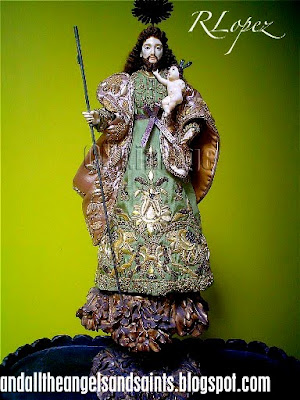 Crèches--or carved models of the Nativity--have been part of the Christmas tradition for nearly 1,000 years. They center around a figure of the Infant Jesus lying in a crib, generally with a small manger as a backdrop.
Crèches--or carved models of the Nativity--have been part of the Christmas tradition for nearly 1,000 years. They center around a figure of the Infant Jesus lying in a crib, generally with a small manger as a backdrop. In the Philippines, the local 'belen' (from "Bethlehem") shows the child Jesus attended by small groups of figures--Mary and Joseph, the Three Kings bearing gifts, a few shepherds and their sheep. More elaborate versions may include a cow and a donkey, sheep, angels, cherubs, camels and ordinary villagers.
In the Philippines, the local 'belen' (from "Bethlehem") shows the child Jesus attended by small groups of figures--Mary and Joseph, the Three Kings bearing gifts, a few shepherds and their sheep. More elaborate versions may include a cow and a donkey, sheep, angels, cherubs, camels and ordinary villagers.
The height of the crèche-builder's art was reached in 18th century Naples, where puppet-like figures with beautiful terra-cotta or wood heads were created. They stood as high as 18 inches and were elaborately dressed, not unlike the rare ivory versions made here.

Peddlers and other travelers eventually carried the crèches throughout Europe, and has since become an international symbol of Christmas. Craftsmen in the Provence region of France to this day produce the traditional small earthenware figures known as "santons" (little saints, in the traditional dialect) that their ancestors began making early in the 19th century. Cast in century-old molds and painted by hand, the figures represent people of the area dressed in period costumes.

The more common Belen santo figures found here are carved in the folk tradition and are but a few inches tall. Getting a complete set is almost next to impossible as small figures tend to be lost. The set is oftentimes broken up too by antique dealers, who sell characters individually--like the Three Kings, or just the figures of Mary, Joseph and Jesus.
 The most interesting figures are those that depict local provincial folks--women with pots on their heads, squatting vendors, and village people dressed in everyday camisa chino and baro't saya.
The most interesting figures are those that depict local provincial folks--women with pots on their heads, squatting vendors, and village people dressed in everyday camisa chino and baro't saya. At one point, the Belen tableaux underwent simplification withe the reduction of characters--the solitary image of a sleeping Nino in ivory on a manger soon became a more popular Christmas fixture.
At one point, the Belen tableaux underwent simplification withe the reduction of characters--the solitary image of a sleeping Nino in ivory on a manger soon became a more popular Christmas fixture.
In many Philippine churches nationwide, it is customary to have a small altar devoted to the Nativity scene, which plays an important role every year during the annual rituals of the Christmas celebration.



















































